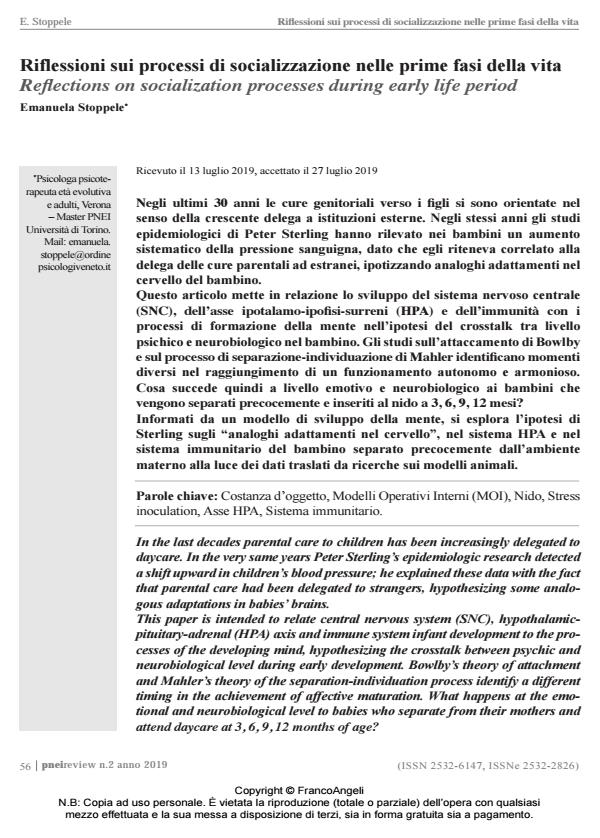Reflections on socialization processes during early life period
Journal title PNEI REVIEW
Author/s Emanuela Stoppele
Publishing Year 2019 Issue 2019/2 Language Italian
Pages 14 P. 56-69 File size 122 KB
DOI 10.3280/PNEI2019-002006
DOI is like a bar code for intellectual property: to have more infomation
click here
Below, you can see the article first page
If you want to buy this article in PDF format, you can do it, following the instructions to buy download credits

FrancoAngeli is member of Publishers International Linking Association, Inc (PILA), a not-for-profit association which run the CrossRef service enabling links to and from online scholarly content.
In the last decades parental care to children has been increasingly delegated to daycare. In the very same years Peter Sterling’s epidemiologic research detected a shift upward in children’s blood pressure; he explained these data with the fact that parental care had been delegated to strangers, hypothesizing some analogous adaptations in babies’ brains. This paper is intended to relate central nervous system (SNC), hypothalamicpituitary- adrenal (HPA) axis and immune system infant development to the processes of the developing mind, hypothesizing the crosstalk between psychic and neurobiological level during early development. Bowlby’s theory of attachment and Mahler’s theory of the separation-individuation process identify a different timing in the achievement of affective maturation. What happens at the emotional and neurobiological level to babies who separate from their mothers and attend daycare at 3, 6, 9, 12 months of age? With a theory of psychic development in mind, we explore Sterling’s hypothesis on the "analogous adaptations in the brain", HPA axis, immune system of the babies who attend daycare early in life by consulting the results of the research on early life stress in animal models.
Keywords: Object constancy, Internal Working Model (IWM), Daycare, Stress inoculation, HPA axis, Immune system.
- Beebe B. e Lachmann F.M. (2015). Le origini dell’attaccamento. Milano: Raffaello Cortina.
- Blom I. and Bergman A. (2013). Observing development: a comparative view of attachment theory and separation-individuation theory. In: Bettmann J.E. and Demetri Fiedman D., eds., Attachment-based clinical work with children and adolescent. Basel: Springer Nature Switzerland. DOI: 10.1007/978-1-4614-4848-8_
- Bonaccorsi M.T. (1993). La nascita psicologica del bambino. Neonatologica, 3: 125-130.
- Bottaccioli F. e Bottaccioli A.G. (2017). Psiconeuroendocrinoimmunologia e scienza della cura integrata. Milano: Edra.
- Bowlby J. (1969/1982). Attachment and loss. Vol.1: Attachment. New York: Basic Books.
- Brett Z.H., Humphreys K.L., Fleming A.S., Kraemer G.W. and Drury S.S. (2015). Using cross-species comparisons and a neurobiological framework to understand early social deprivation effects on behavioral development. Dev. Psychopathol., 27(2): 347-367. DOI: 10.1017/S095457941500003
- Cassidy J., Jones J.D. and Shaver P.R. (2013). Contributions of attachment theory and research: a framework for future research, translation and policy. Dev. Psychopathol., 25(4Pt2): 1415-1434. DOI: 10.1017/S095457941300069
- Coe C.L., Lubach G. and Ershler W.B. (1989). Immunological consequences of maternal separation in infant primates” Infant Stress and Coping. New Dir. Child Dev., 45: 65-91.
- Danese A. and Lewis S.J. (2017). Psychoneuroimmunology of early-life stress: the hidden wounds of childhood trauma?. Neuropsychopharmacology, 42(1): 99-114.
- Dixson A. (2009). Primate sexuality: comparative studies of the prosimians, monkeys, apes, and humans. Oxford: University Press.
- Dutta S. and Sengupta P. (2015). Men and mice: relatig their ages. Life Sci., 152: 244-248.
- Ehrlich K.B. (2018). Attachment and Psychoneuroimmunology. Curr. Opin. Psychol., 25: 96-100.
- Eisenberger N.I. and Cole S.W. (2012). Social neuroscience and health: neurophysiological mechanisms linking social ties with physical health. Nat. Neurosci., 15: 669-674.
- Eisenberger N.I., Moieni M., Inagaki T.K., Muscatell K.A. and Irwin M.R. (2017). In sickness and in health: the co-regulation of inflammation and social behavior. Neuropsychopharmacology, 42(1): 242-253.
- Fagundes C.P., Glaser R. and Kiecolt-Glaser J.K. (2013). Stressful early life experiences and immune dysregulation across the lifespan. Brain Behav. Immun., 27(1): 8-12.
- Fraiberg S. (1969). Libidinal object constancy and mental representation. Psychoanal. Study Child, 24: 9-47. DOI: 10.1080/00797308.1969.1182268
- Gergely G. (2000). Reapproaching Mahler: new perspectives on normal autism, symbiosis, splitting and libidinal object constancy from cognitive developmental theory. J. Am. Psychoanal. Assoc., 48(4): 1197-1228. DOI: 10.1177/0003065100048004080
- Gunnar M.R. (2017). Social buffering of stress in development: a career perspective. Perspect. Psychol. Sci., 12(3): 355-373. DOI: 10.1177/174569161668061
- Hartmann H. (1952). Essays on ego psychology. New York: International University Press.
- Hofer M.A. (2006). Psychobiological roots of early attachment. Curr. Dir. Psychol. Sci., 15(2): 84-88.
- Hostinar C.E. and Gunnar M.R. (2013). Future directions in the study of social relationships as regulators of the HPA axis across development. J. Clin. Child Adolesc. Psychol., 42(4): 564-575. DOI: 10.1080/15374416.2013.80438
- Kandel E. (2007). Psichiatria, psicoanalisi e nuova biologia della mente. Milano: Raffaello Cortina.
- Lupien S.J., McEwen B.S. and Heim C. (2009). Effects of stress throughout the lifespan on the brain, behaviour and cognition. Nat. Rev. Neurosci., 10: 434-445.
- Mahler M. S., Pine F. and Bergman A. (1975). The psychological birth of the human infant. New York: Basic Books.
- Miller G.E., Chen E. and Parker K.J. (2011). Psychological stress in childhood and susceptibility to the chronic disease of aging: moving towards a model of behavioral and biological mechanisms. Psychol. Bull., 137(6): 959-997.
- Parker K.J. and Maestripieri D. (2011). Identifying key features of early stressful experiences that produce stress vulnerability and resilience in primates. Neurosci. Biobehav. Rev., 35(7): 1466-1483.
- Sterling P. (2004). Principles of Allostasis: Optimal Design, Predictive Regulation, Pathophysiology, and Rational Therapeutics. In Schulkin J., ed., Allostasis, homeostasis, and the costs of physiological adaptation. New York:: Cambridge University Press.
- Tyson P. (1996). Object relations, affect management and psychic structure formation:
- the concept of object constancy. Psychoanal. Study Child, 51: 172-189. DOI: 10.1080/00797308.1996.11822426
- Vela R.M. (2014). The effect of severe stress on early brain development, attachment, and emotions. Psychiatr. Clin. North Am., 37(4): 519-534.
- Van Bodegom M., Homberg J. and Henckens M.J.A.G. (2017). Modulation of the HPA axis by early life stress exposure. Front. Cell. Neurosci., 11: 87.
Emanuela Stoppele, Riflessioni sui processi di socializzazione nelle prime fasi della vita in "PNEI REVIEW" 2/2019, pp 56-69, DOI: 10.3280/PNEI2019-002006